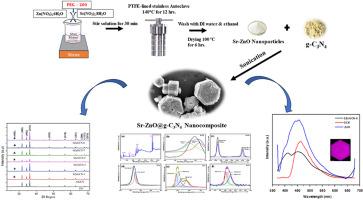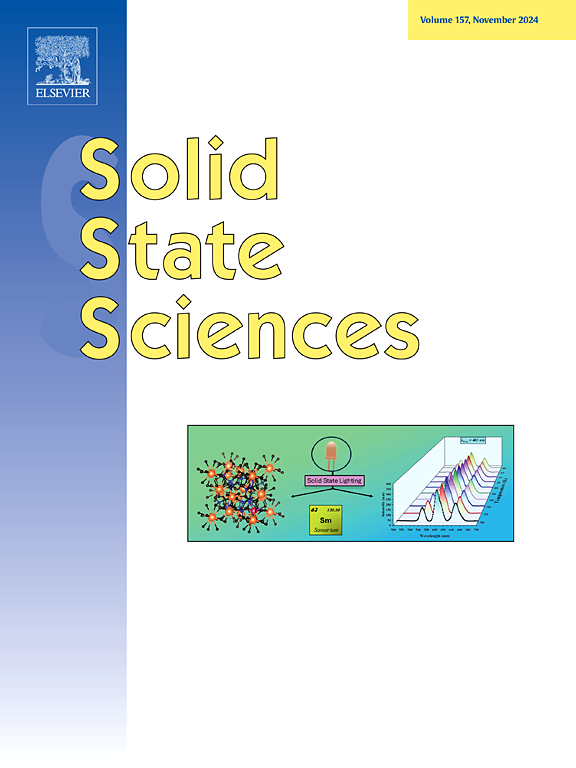通过Sr掺杂调整ZnO@ g-C3N4纳米复合材料的结构和化学性质:来自多技术表征的见解
IF 3.3
3区 化学
Q2 CHEMISTRY, INORGANIC & NUCLEAR
引用次数: 0
摘要
采用水热法合成了0 - 8% Sr掺杂ZnO@g-C3N4的纳米复合材料,并对其进行了综合表征。研究通过x射线衍射(XRD)技术证实了ZnO@g-C3N4纳米复合材料的相纯度和Sr的成功掺杂。傅里叶变换红外光谱(FTIR)分析进一步支持了纳米复合材料中金属-氧键以及各种官能团的鉴定。场发射扫描电子显微镜(FESEM)成像显示了ZnO@g-C3N4纳米复合材料和Sr-ZnO@g-C3N4纳米复合材料的六角形纳米圆盘结构,透射电子显微镜(TEM)观察证实了这一发现。能量色散x射线光谱(EDAX)分析证实了合成的纳米复合材料的元素组成。采用紫外-可见光谱法研究了原始ZnO和Sr-ZnO@g-C3N4纳米复合材料的光学性质。随着Sr含量的增加(从0到5%),Sr掺杂ZnO的红移增强,证实了Sr掺杂水平的提高。而当Sr在ZnO中含量为7%和8%时,其吸收率降低,这是由于ZnO中Sr含量增加所致。x射线光电子能谱(XPS)提供了对元素氧化态的深入了解,特别是在5% Sr-ZnO@g-C3N4纳米复合材料中。对合成样品进行了光致发光(PL)光谱,以检测纳米复合材料内部的载流子动力学和缺陷状态。合成的Sr-ZnO@g-C3N4纳米复合材料可用于储能装置、环境修复和有机转化。本文章由计算机程序翻译,如有差异,请以英文原文为准。

Tailoring structural and chemical properties of ZnO@ g-C3N4 nanocomposites through Sr doping: Insights from multi technique characterization
Nanocomposites comprising 0–8 % Sr doped ZnO@g-C3N4 were synthesized hydrothermally and comprehensively characterized. The study confirmed phase purity and successful Sr doping in ZnO@g-C3N4 nanocomposite through X-ray diffraction (XRD) technique. Fourier Transform Infrared Spectroscopy (FTIR) analysis, further supported identification of metal-oxygen bonds as well as various functional groups within the nanocomposites. Field emission scanning electron microscopy (FESEM) imaging revealed hexagonal nano disk-shaped structures of both ZnO@g-C3N4 nanocomposite and Sr-ZnO@g-C3N4 nanocomposite, a finding corroborated by Transmission Electron Microscopy (TEM) observations. Energy dispersive X-ray Spectroscopy (EDAX) analysis confirmed the elemental composition of the synthesized nanocomposites. Optical properties of pristine ZnO and Sr-ZnO@g-C3N4 nanocomposite were examined using Ultraviolet–Visible (UV–Visible) spectroscopy. With the increase in the percentages of Sr (from 0 to 5 %), the red shift of Sr-doped ZnO intensifies, which confirm higher levels of Sr doping. Whereas Sr with 7 and 8 % percent in ZnO, there is decrease in absorption, this is due to the increased of Sr content within the ZnO. X-ray photoelectron spectroscopy (XPS) provided insights into the oxidation states of elements, particularly in the 5 % Sr-ZnO@g-C3N4 nanocomposite. The Photoluminescence (PL) spectra of as-synthesized samples were carried out to check the charge carrier dynamics and defect states within the nanocomposite materials. The synthesized Sr-ZnO@g-C3N4 nanocomposites may find its uses in the energy storage devices, environmental remediation, and organic transformations.
求助全文
通过发布文献求助,成功后即可免费获取论文全文。
去求助
来源期刊

Solid State Sciences
化学-无机化学与核化学
CiteScore
6.60
自引率
2.90%
发文量
214
审稿时长
27 days
期刊介绍:
Solid State Sciences is the journal for researchers from the broad solid state chemistry and physics community. It publishes key articles on all aspects of solid state synthesis, structure-property relationships, theory and functionalities, in relation with experiments.
Key topics for stand-alone papers and special issues:
-Novel ways of synthesis, inorganic functional materials, including porous and glassy materials, hybrid organic-inorganic compounds and nanomaterials
-Physical properties, emphasizing but not limited to the electrical, magnetical and optical features
-Materials related to information technology and energy and environmental sciences.
The journal publishes feature articles from experts in the field upon invitation.
Solid State Sciences - your gateway to energy-related materials.
 求助内容:
求助内容: 应助结果提醒方式:
应助结果提醒方式:


